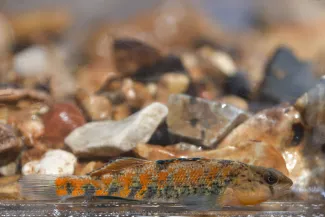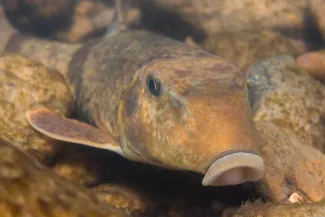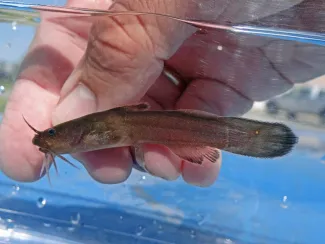Oklahoma is well-known for its outstanding fishing opportunities but beyond our state’s familiar bass, crappie, and catfish swim schools of incredibly diverse and little-known fish.
More than 170 fish species have been documented in the state, from the sizeable alligator gar and paddlefish to game fish like largemouth bass and white crappie, and the uniquely shaped sturgeon, lamprey, and eel. Regardless of their shape, size, or specialty, each native species plays a valuable role in its community.
Oklahoma’s Darters
They’re Pocket-sized but Can Pack a Colorful Punch

Orangethroat darter.
Some of Oklahoma’s most colorful fish are also some of the most overlooked. Despite their vivid breeding colors and patterns, Oklahoma’s 32 darter species often go unnoticed because of their small size (averaging just over 2.5 inches at maturity, ranging from 1.5 to 7 inches) and tendency to dart behind or under small pebbles found on the bottom of the stream.
Overall, darters have a relatively limited range within the state, and most are restricted to watersheds within the Ozark or Ouachita mountains. Aquatic insects are the primary food source, and a majority of Oklahoma’s darters breed and are most colorful in early to mid-spring.
A handful of darters, like the orangethroat darter, may be relatively common where they occur, while others, like the federally threatened leopard darter, state endangered longnose darter, and state threatened blackside darter may be quite rare. One-half of Oklahoma’s darters are considered species of greatest conservation need. And because five species, the Arkansas darter, crystal darter, goldstripe darter, harlequin darter, and river darter are considered species of special concern, their harvest must be reported to the Wildlife Department’s Fisheries Division.
Suckerfish
Hoovers of our Streams and Rivers

Northern hog sucker.
Oklahoma has 16 species of native suckerfish, all with varying degrees of downturned mouths and fleshy lips. This distinctive alignment allows most sucker fish to feed on aquatic invertebrates living on the bottom of the stream or river. The bigmouth buffalo, the sucker with perhaps the most up-turned mouth, instead filters plankton.
Suckerfish may be found in a variety of habitats; northern hog suckers are most often associated with deep riffles in Ozark streams, blue suckers are limited to fast-moving rivers and larger impoundments, and the river carpsucker seems more tolerant of turbid waters and can be found statewide.
Beyond their attention-grabbing physique, suckerfish have been in the spotlight for their impressive records. Research on bigmouth buffalo in northern states and Canada have found the species to live up to 127 years. Closer to home, our warmer water buffalofishes don't live quite as long, but they still reach impressive ages, especially compared to short-lived game fishes. For example, our state record smallmouth buffalo, caught in 2019 from Broken Bow Lake, was found to be a 62-year-old female and is now the oldest known individual of its species. Similarly, the Wildlife Department has aged a black buffalo from Texoma lake at 54 years old in 2021.
When viewed in the water from above, some larger suckers and other native nongame fish with oblong body shapes may be lumped in with, or mistaken for, nonnative invasive carp. Carp are unrelated members of the Cyprinidae family, and the common carp can be distinguished by having barbels near the mouth.
Three Oklahoma suckerfish, the black buffalo, blue sucker, and shorthead redhorse, are considered species of greatest conservation need. Because these species are also considered species of special concern, their harvest must be reported to the Wildlife Department’s Fisheries Division.
Madtoms
Oklahoma’s Smallest Catfish

Freckled madtom.
Anglers have pulled some massive catfish from Oklahoma waters, but most of our state’s 13 catfish species could fit in the palm of your hand. The seven species known as “madtoms” (no, they’re not baby catfish but instead members of the catfish genus Noturus) average a little over 3.5 inches at maturity, with the largest species, the stonecat, coming in at a maximum length of 7 inches.
Most madtoms prefer clear water with a stronger current, though some prefer softer-bottomed streams, and others choose sluggish rivers. By and large, madtoms have a relatively small range in Oklahoma, mostly limited to the eastern half of the state. They typically hide in leaf litter or under stones during the day and feed on aquatic insects at night. Like other catfish, madtoms guard their nests.
Two species, the mountain madtom and Neosho madtom, are considered species of greatest conservation need. The Neosho madtom is also a federally threatened species. And because two species, the mountain madtom and stonecat, are considered species of special concern, their harvest must be reported to the Wildlife Department’s Fisheries Division.